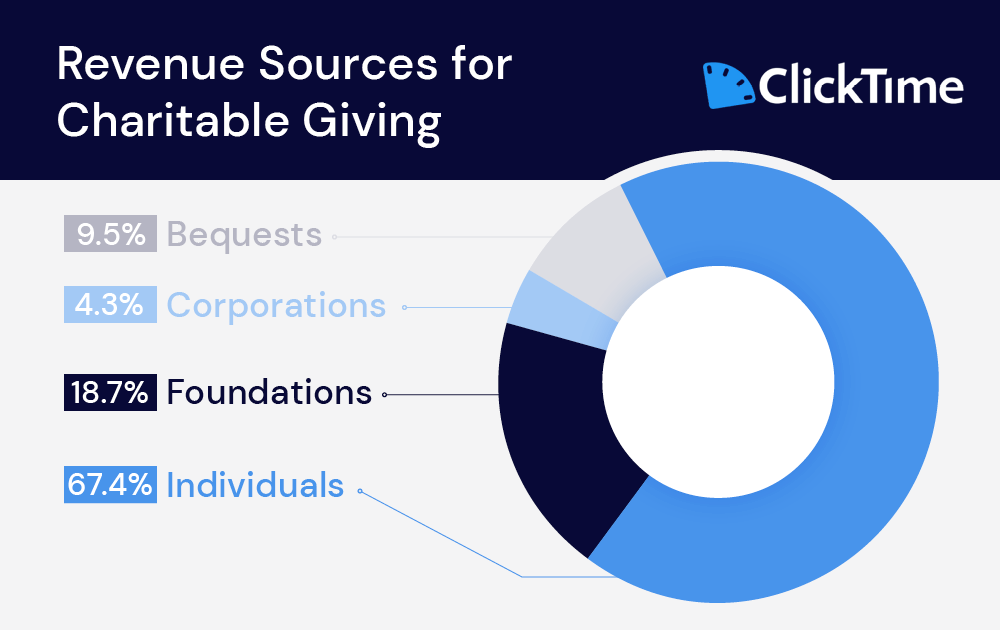How to Write a Grant (And Win!)
Table of Contents
Billions of dollars in grants are awarded to nonprofits every year. For many organizations, grant funding makes up a sizeable portion of their revenue. In fact, the annual Giving USA report found that grants from foundations comprised 19% of all charitable giving in recent years. And that doesn’t even factor in grants awarded by companies, like volunteer grants!
Unsurprisingly, grants made by foundations are the second largest category of charitable giving, falling only behind individual donations. For nonprofit fundraisers, understanding how to write a grant proposal instrumental to the success of their work.
If you want to tap into billions awarded via grants, you’ve come to the right place. With cash like that on the table, it’s fair to say that competition is fierce. Many organizations vie for the chance to win grants, and it’s usually a good tactic to go after several at a time as they can be difficult to obtain.
Many go down the same path by the time it comes to submitting the actual proposal. We’ll run through the basics of nonprofit grant writing and offer some resources where you can go more in-depth. Then, we’ll share our secrets on how to win them for your cause.
Why To Spend Time Improving Your Nonprofit Grant Writing
At its core, acquiring grants will allow you to fund your work. You’ll open the door to vital funding that can make your projects (and therefore your mission) a success. How well you articulate your goals will determine whether you win a grant.
Beyond acquiring funds for your cause, there are plenty of other advantages to improving your grant proposals. Here’s a quick rundown of the benefits of effective nonprofit grant writing:
- You’ll form powerful connections with grant-making organizations. Grants present a vital networking opportunity, and forming relationships with grantmakers will potentially open the door to future funding opportunities, too.
- You’ll be able to demonstrate your goals. Compelling writing will enable you to articulate the importance of your cause and vision. You’ll be able to lay out exactly what you want to accomplish and the steps you’ll take to get there.
- Your nonprofit will make its case for support. Competition for grants can be fierce. Spending time improving your writing skills will enable you to create stand-out applications, making you more likely to win the grant.
Grants fuel nonprofit missions. You must write your proposals effectively to stand out from other applicants and inspire grantmakers to invest in your projects.
Types of Nonprofit Grants
Before writing a grant proposal, determine what types of funding will best support your work. For instance, nonprofits that want to invest in marketing might apply for the Google Ad Grant, while organizations that need funding for a nationwide program might apply for a federal grant.
You can break the different grant types into a few categories.
Government Grants
A government grant is awarded by the federal, state, or local government to fund worthwhile projects that will benefit the community and stimulate the economy. Funded by tax dollars, these grants often have stringent compliance and reporting requirements.
These types of grants usually support programs like critical recovery initiatives, innovative research, and other projects that serve a public purpose. They’re usually classified by service area:
- Federal: These grants are bestowed to any nonprofit across the country.
- State: These grants are limited to nonprofits in a particular state.
- Local: These grants are only for nonprofits in a specific district or community.
Government grants aren’t bestowed — they have an application process. They often have large application pools, making it an incredibly competitive process. In other words, you’ll need extensive background knowledge about how to write a grant proposal.
Foundation Grants
Foundations are nonprofit organizations or charitable trusts that fund other nonprofits. They’re classified as either private or public foundations based on how they receive their funding:
- Private foundations. These are funded by a single source, typically a family or another funder. These can be excellent funding sources, because you can appeal to the funder directly.
- Public foundations. These organizations receive money from various sources, like the government, multiple individuals, or several families. These charitable grantmakers receive their funds from the general public.
Like we mentioned, foundation grants make up a major part of charitable giving. They provided nearly $91 billion to U.S. organizations in 2021 according to the same GivingUSA report. So consider foundations in your grant search.
Corporate Grants
Some companies offer grants as a way to support charitable causes that align with their missions. Businesses that engage in corporate philanthropy aspire to build a positive brand image, strengthen employee engagement, and ultimately give back to the communities that support them.
Big-name corporations like Google, Microsoft, and Disney all offer various corporate giving initiatives. However, you can also look at local businesses for grant opportunities. Here are some powerful grant opportunities that any nonprofit can tap into:
- Google Ad Grants: This specific type of marketing grant is a little different from a traditional grant. Getting Attention’s Google Ad Grant guide explains that the program “gives eligible nonprofits $10,000 in free advertising credits every month. Organizations can use their grant money to bid on different keywords and promote specific pages on their website through text-based ads [on Google Search].” Any nonprofit that meets the eligibility requirements can fill out the application. It takes some time to apply, but it’s an effective way to build your digital presence.
- Volunteer Grants: This is one of the most popular corporate grants. In fact, fundraising research estimates that 40% of Fortune 500 companies offer volunteer grant programs. Businesses offer this as a way to support employees’ volunteer efforts. When an employee volunteers frequently with your nonprofit, they’ll apply for the grant on your behalf.
The process for applying for corporate grants is typically nonstandard. Instead of writing a grant proposal, you’ll often have to follow a series of steps to acquire the funding. In many cases, any organization that meets the conditions will receive the grant.
How to Find Grants for Nonprofits
There are several places to find grants. You can start by visiting the government’s grant page. Grants.gov is a free, comprehensive resource for finding and applying for federal grant programs. It houses information on more than 1,000 grant programs.
You can also sign up for The Chronicle of Philanthropy newspaper, which has upcoming application deadlines and endless information on nonprofit grant writing. But these days, you can find almost all the grants you want online.
Some other great sources to check out include the Foundation Center, GrantWatch, Instrumentl, and Guidestar.
When searching for grants, narrow your focus to the most relevant opportunities. Remember, grants are given to many different categories. Each digital resource has a different focus and offers differ filters to help you narrow your search.
How to Prepare for Nonprofit Grant Writing
Finding potential grant opportunities is only the first step! You can do a lot between the time you find a grant and write your proposal. Here are some steps to prepare yourself:
- Do your research. Know the grant’s mission statement and guidelines inside and out, and be sure that what you’re proposing is a perfect fit.
- Check your current network for connections. Scan Facebook and LinkedIn to see if you’re connected to individuals working at grant organizations or have experience at one. Don’t be afraid to ask for advice, and if appropriate, warm introductions to establish credibility and spread your name.
- Reach out to prospective grantmakers. Often, grant seekers wonder if it’s better to contact grantmakers directly. This can be a good tactic if the grantmaker is open to talking with you. In fact, Grants Plus’ guide to nonprofit grant writing explains that cultivating relationships with funders is vital. Using one of your connections, set up a meeting to ask meaningful questions and make the conversation as valuable and worthwhile as possible for the both of you.
Once you’ve found a few grants to submit proposals to, double-check them to ensure you qualify. It’s possible that grants are only allotted in certain geographic areas or have other conditions you have to meet. Take the time up front to confirm you’re eligible before spending time writing a grant proposal.
How To Write Your Nonprofit Grant Proposal
You’ve found the perfect grant to apply for and scoured the requirements with a fine-tooth comb — now it’s time to win it! To write a compelling grant proposal, you can breakdown the process into these steps:
- Step 1: Make sure your focus is clear. Target who you’d like to help, why this is a notable problem, and how you expect the grant will help achieve the goals for which you’re striving.
- Step 2: Create a descriptive and urgent problem statement. Funders should understand how the community is impacted by the current situation, why help is needed, and why you need to take action right away.
- Step 3: Include powerful statistics and examples. Choose stats to sprinkle throughout from beginning to end. You want them to trust you know what you’re doing — whether you’re already an established organization or just getting started.
- Step 4: Do your research. Tailor your grant writing by researching the grantmaker’s history and reviewing past recipients. How did the previous winners categorize their proposals, and what did they focus on or do well? How did they come to the research they’re presenting? Seeing the range of assets the grantmaker has can give you a good idea of how much to request. Ask for a little less if you’re newer in the scene, and aim higher if you’re better established.
- Step 5: Be fascinating. Use storytelling to bring forth empathy to encourage action now rather than later. A compelling proposal is more likely to be remembered and elicit an emotional connection to your cause.
- Step 6: Follow the application rules. Failing to follow the application requirements is the number one reason grant applications get rejected. If they ask for 12 pages, don’t squish in another page or seven with .5 font — that’s just torturous. If they want two copies of each document, make two copies of each. This simple step will put you ahead of the game substantially.
- Step 7: Proofread, proofread, proofread! Make sure your math adds up and your words flow flawlessly. Nothing commands attention like a mistake-free proposal.
Try out these strategies, and you’re sure to craft a winning proposal! If you want to dive further into the nonprofit grant-writing world, continue researching what grantmakers are looking for before you start drafting your proposal.
Dos and Don’ts Before You Submit Your Grant Proposal
Do talk about funding important causes that will deliver results for funders and the community.
Do be very clear with your goals, your plans for achieving those goals, and how you intend to maximize the charity’s resources.
Do demonstrate how you plan to make spending more efficient.
Do have someone with experience review your proposal, and ask for any advice.
Do check your eligibility for the grant. Grantmakers will often lay out requirements (even the Google Ad Grants program has eligibility requirements). Verifying that you’re eligible first will save time.
Don’t send in multiple copies. It’s confusing, unprofessional, and extra work for the grantmaker. Serve your proposal on a pristine platter, not a heap of repetition.
Don’t write a vague grant proposal and send it to multiple grantmakers. This doesn’t cast a wider net — it just dulls a potentially sharp hook.
Don’t apply for all of the grants a grantmaker offers in the hopes that one is selected. Tailoring your proposal with a dominant purpose makes it far more likely to get picked.
Don’t wait until the last minute! Most proposals sent at the end of the year are simply too late and have an extremely low chance of even getting viewed. Be early, and you’ll already be more likely to win.
Don’t forget to create a plan for how you’ll meet the grant compliance requirements and streamline the reporting process as much as possible.
Once You’ve Submitted Your Nonprofit Grant Proposal
As grant organizations receive enormous amounts of applications, it can take roughly 6-12 weeks before hearing back from one.
If you have won any grants in the past, it’s good practice to keep grantmakers updated on your project and thank them again =for their generosity. Remember, these relationships are key if you plan on securing more grants in the future.
If you happen to receive a rejection letter, stay in touch and thank them for their time. It can take a few tries with the same grantmaker before you’re successful, but always follow through and maintain a pleasant demeanor in your communications — they are the ones with the wallet, after all.
With these tips, you should be well on your way to securing that grant for your dreams. Happy grant-hunting, and even happier grant-winning!
House of Blues Foundation increases employee productivity by 15%
Learn how House of Blues is able to better focus on its mission and greatly reduce operational time and effort.














